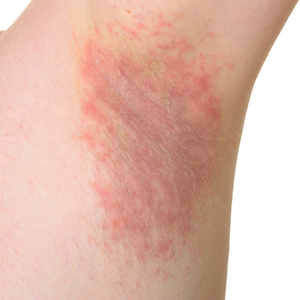
What is erythrasma?
Erythrasma is a bacterial infection of the top layer of the skin, which is usually harmless and also known under the synonym bear jumping disease. Erythrasma mainly occurs on moist skin areas, such as the armpit and/or groin area, but can also develop between the toes and/or under the breast. Approximately 5 percent of the population in Central Europe suffers from erythrasma, which is relatively common, although this skin disease is more common in tropical regions. On average, more men than women are affected by the disease, which can also quickly take on a chronic course.
Erythrasma appears as a discolouration of the skin, which is clearly demarcated and can become larger as the disease progresses. In most cases, erythrasma can be treated with ointments or creams.
How does erythrasma develop?
Erythrasma is usually caused by the bacterium Corynebacterium minutissimum, which is a natural part of the human skin flora and therefore does not usually cause a skin disease. However, people who suffer from immunodeficiency (immunosuppression), diabetes mellitus or overweight (obesity) and/or who sweat excessively (hyperhidrosis) tend to develop erythrasma. The risk of developing erythrasma increases if the patient spends a lot of time in a warm, humid climate, as the skin disease also particularly affects those parts of the body that remain slightly moist due to perspiration. These include, for example, the armpits, the groin region and the genital area as well as the spaces between the toes and the skin areas under the breast. In overweight patients, the skin folds of the abdominal wall are also often affected.
When erythrasma develops, the bacteria attack the upper third of the epidermis (stratum corneum). The corynebacteria settle in the intercellular space as well as inside the skin cells.
What are the symptoms of erythrasma?
Erythrasma initially manifests itself as a uniform reddish discolouration of the skin, which is clearly distinguishable from the rest of the skin, but otherwise does not cause any symptoms. Over time, the affected areas of skin change colour, become brownish and may develop fine wrinkles called lichenifications. In addition, the skin may begin to flake, take on a rough appearance, show small cracks and tend to sweat more. Some patients also complain of unpleasant itching of the affected skin areas.
How is erythrasma diagnosed?
Although the external skin changes of erythrasma are quite typical, it is usually difficult to distinguish the disease from other skin inflammations such as a fungal infection or psoriasis. To make a reliable diagnosis, the dermatologist will therefore use a UV lamp (so-called Wood lamp). The light under a UV lamp causes the affected skin area to fluoresce coral red. This is due to the fact that the triggering bacterium of an erythrasma produces a fluorescent substance (a so-called porphyrin) by the corny bacteria. In addition to examination with a UV lamp, the cornybacteria can also be detected demonstrably by a skin flake sample.
How is erythrasma treated?
As a rule, the affected skin areas are treated with an ointment for two to four weeks. There are different active substances. Besides the antimycotic bifonazole, cotrimazole can also be used. But certain antibacterial ointments such as clindamycin, erythromycin or fusidic acid can also provide relief. If, on the other hand, the erythrasma is severe, systemic antibiotic therapy, for example in the form of clarithromycin, may also be necessary.
In addition to medical treatment, the patient should try to keep the corresponding skin areas dry. For example, the skin area can be carefully patted dry after showering or bathing. People who tend to sweat excessively should also dab the skin area dry again and again during the course of the day. In addition, all those affected should use soaps with a rather low pH value, as these can kill the bacteria early on. Greasy ointments should also be avoided.
What are the chances of curing erythrasma?
If erythrasma is left untreated, the skin infection is likely to increase in size, but usually does not lead to further complications apart from possible additional infections. Despite successful treatment, the skin discolouration may still persist for some time. It also cannot be ruled out that erythrasma will reoccur. It is therefore important to prevent erythrasma prophylactically by keeping the affected skin areas dry as a precaution. Patients should also wear breathable clothing, especially in situations where they sweat a lot. If one suspects that one is suffering from pathological sweat production, one should seek medical treatment in order to initiate the appropriate treatment options at an early stage.
